Leadership Models, Motivation, Culture and Diversity: A Report
VerifiedAdded on 2023/06/15
|9
|2633
|151
Report
AI Summary
This report delves into the critical role of leadership in managing organizational culture and diversity, with a focus on Tesco as a case study. It examines inclusive leadership models, highlighting fairness, collaboration, and cultural intelligence as key components for enhancing firm performance. The report also evaluates transformational, autocratic, and democratic leadership styles, alongside Victor Vroom’s expectancy theory of motivation, emphasizing the importance of expectancy, instrumentality, and valence in driving employee productivity. Furthermore, it discusses how leaders influence organizational culture through purpose, accomplishment, and interpersonal connections, detailing strategies such as observing for insight, open communication, and acting on feedback. The report concludes by underscoring the functions of organizational culture in providing identity, fostering commitment, clarifying vision, and defining rewards, ultimately asserting that effective leadership is essential for achieving organizational goals and fostering a positive, inclusive work environment.
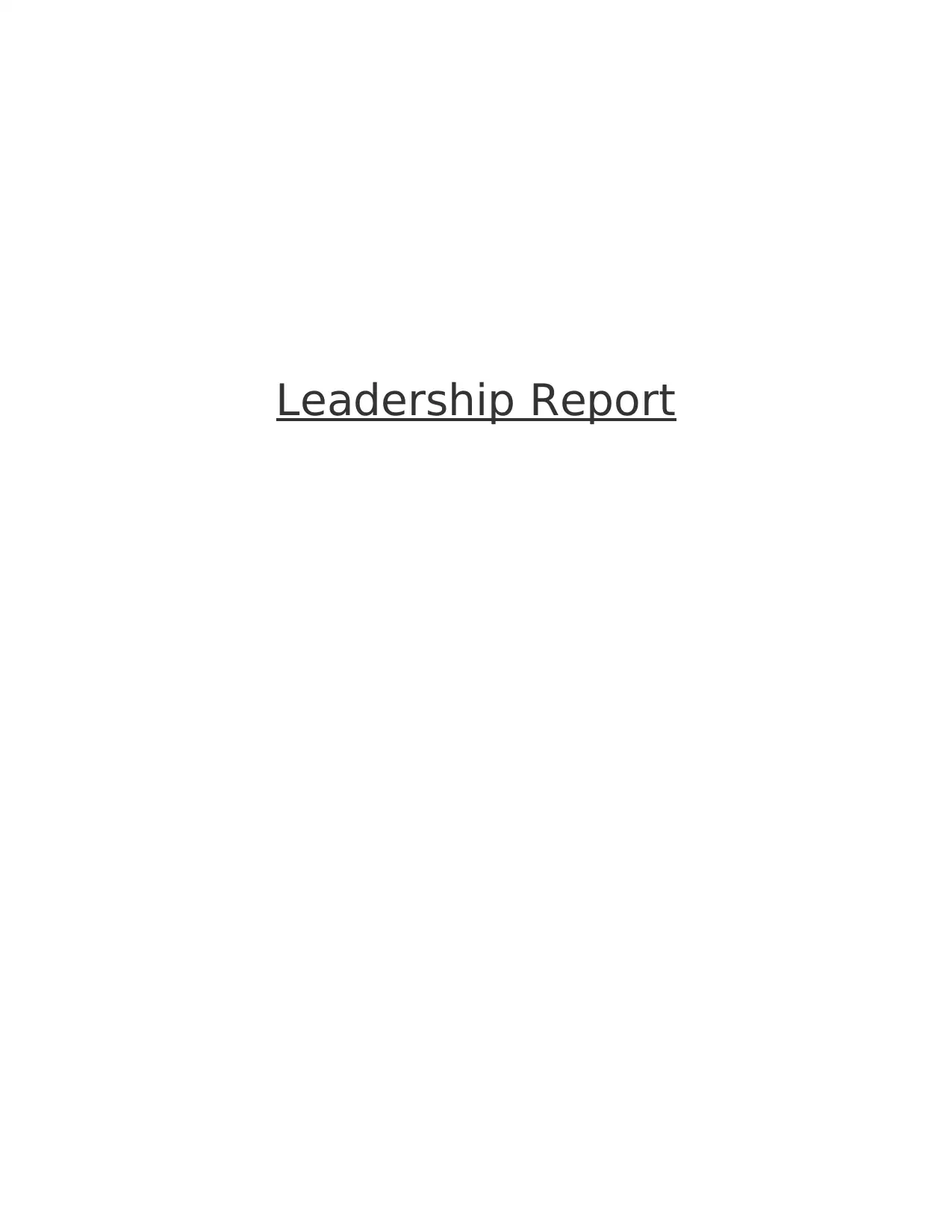
Leadership Report
Paraphrase This Document
Need a fresh take? Get an instant paraphrase of this document with our AI Paraphraser

TABLE OF CONTENT
INTRODUCTION...........................................................................................................................3
MAIN BODY...................................................................................................................................3
Inclusive Leadership model and impact on firm performance:...................................................3
Leadership model contain leadership style:.................................................................................4
Demonstrating evaluation of understanding of leadership theories and practice of motivation: 5
Impact of leadership on culture and diversity management........................................................5
CONCLUSION................................................................................................................................8
REFERENCES................................................................................................................................1
INTRODUCTION...........................................................................................................................3
MAIN BODY...................................................................................................................................3
Inclusive Leadership model and impact on firm performance:...................................................3
Leadership model contain leadership style:.................................................................................4
Demonstrating evaluation of understanding of leadership theories and practice of motivation: 5
Impact of leadership on culture and diversity management........................................................5
CONCLUSION................................................................................................................................8
REFERENCES................................................................................................................................1

INTRODUCTION
Leadership is one of the most important element in managing people and their
productivity in the business organization, this allows company to guide employee and make
effective use of their performance in achievement of organizational goal (Northouse, 2021). This
study is based on Tesco, company is third largest retailer in the world. This report will discuss
inclusive leadership theory and models and understand their impact on firms performance. Later
this report will discuss leadership style of the school of leadership. At last this report will discuss
impact of leadership on organizational culture and diversity management in the business
organization.
MAIN BODY
Inclusive Leadership model and impact on firm performance:
Inclusive leadership means leader who can manage heterogeneous group of employee
who belong to diverse culture, these type of leadership allow person to respect uniqueness of
different culture and use them in the best way to improve organizational performance (Bourke,
Titus and Espedido, 2020). Inclusive leaders quickly mould themselves in diverse situation to
manage any cultural diversity issue that have arises in the workplace. In today's world, every
bsuiness organization is now adopting inclusive leadership style to manage their culture and its
diversity, it is very clear that every workplace have employee who belong to diverse culture and
have different belief. If business organization have capacity to manage diversity of culture then
not only their performance will be improved but this will allow them to capture competitive
advantage in the market as well.
Many large firms like Tesco have adopted inclusive leadership, as they named this
leadership as new capacity of leaders. There are different styles of inclusive leader which allow
them to manage and lead people in the business organization, these styles are:
Fairness and respect: it is very clear that leader has to be fair in leadership process, fairness
allow them to become role model of their followers. Inclusive leadership increase fairness in the
workplace by respecting people and their diversity, these leaders know performance of employee
decide performance of organization.
Collaboration: collaboration means working together to achieve organizational goal, inclusive
leaders actively participate in group and share their experience and affords in accomplishment of
Leadership is one of the most important element in managing people and their
productivity in the business organization, this allows company to guide employee and make
effective use of their performance in achievement of organizational goal (Northouse, 2021). This
study is based on Tesco, company is third largest retailer in the world. This report will discuss
inclusive leadership theory and models and understand their impact on firms performance. Later
this report will discuss leadership style of the school of leadership. At last this report will discuss
impact of leadership on organizational culture and diversity management in the business
organization.
MAIN BODY
Inclusive Leadership model and impact on firm performance:
Inclusive leadership means leader who can manage heterogeneous group of employee
who belong to diverse culture, these type of leadership allow person to respect uniqueness of
different culture and use them in the best way to improve organizational performance (Bourke,
Titus and Espedido, 2020). Inclusive leaders quickly mould themselves in diverse situation to
manage any cultural diversity issue that have arises in the workplace. In today's world, every
bsuiness organization is now adopting inclusive leadership style to manage their culture and its
diversity, it is very clear that every workplace have employee who belong to diverse culture and
have different belief. If business organization have capacity to manage diversity of culture then
not only their performance will be improved but this will allow them to capture competitive
advantage in the market as well.
Many large firms like Tesco have adopted inclusive leadership, as they named this
leadership as new capacity of leaders. There are different styles of inclusive leader which allow
them to manage and lead people in the business organization, these styles are:
Fairness and respect: it is very clear that leader has to be fair in leadership process, fairness
allow them to become role model of their followers. Inclusive leadership increase fairness in the
workplace by respecting people and their diversity, these leaders know performance of employee
decide performance of organization.
Collaboration: collaboration means working together to achieve organizational goal, inclusive
leaders actively participate in group and share their experience and affords in accomplishment of
⊘ This is a preview!⊘
Do you want full access?
Subscribe today to unlock all pages.

Trusted by 1+ million students worldwide

goals and objectives in group working, there are greater chance of bias and cross culture issue.
Inclusive leaders actively listen to each member regarding their role and seniority level.
Cultural intelligence: culture intelligence is one of the most used style of inclusive leaders, this
allow them to keep empathy first to avoid any disrespectful and discrimination act in the
workplace. Inclusive leaders know that cultural intelligence is key to become more competitive
in market and increase firms performance (Wuffli, 2016).
Leadership model contain leadership style:
Transformational leadership model: transformational leadership means friendly leader who
tend to have integrity as core value, these type of leaders communicate with staff and effectively
work with them in the achievement of organizational goal (Budur, 2020). Transformational
leaders show integrity and respect to staff member and guide them to accomplish organizational
goals. It is very clear that without inspiring and motivating employee, their productivity can not
be enhanced which means overall performance of firm will be impacted. There are different
leadership style, these are:
Autocratic leadership style: autocratic leaders are more straight forward as they only want work
as first priority in the workplace, these leaders do not involve in decision-making process of the
company. Autocratic leaders keep control over employee, these leaders need employee to
increase their performance to only focusing on their intended work. Every large scale business
organisation adopt this leadership style which allow them to manage people systematically, there
are certain benefit of this leadership such as more improved organisational performance and
better outcome.
Democratic leadership style: democratic leaders are more friendly and work collaboratively with
employee, these leader try to increase productivity of employee by providing them effective
guidance. Democratic leaders allow employee to participate in decision-making process, many
leaders think that participation of employee in decision-making process will increase their
confident resulting in improved organisational performance. Employee to keep their productivity
high in the workplace may have chance to participate in crucial decision of the company.
Democratic leaders is not mainly adopted by large scale business organization because this slow
down business process.
Inclusive leaders actively listen to each member regarding their role and seniority level.
Cultural intelligence: culture intelligence is one of the most used style of inclusive leaders, this
allow them to keep empathy first to avoid any disrespectful and discrimination act in the
workplace. Inclusive leaders know that cultural intelligence is key to become more competitive
in market and increase firms performance (Wuffli, 2016).
Leadership model contain leadership style:
Transformational leadership model: transformational leadership means friendly leader who
tend to have integrity as core value, these type of leaders communicate with staff and effectively
work with them in the achievement of organizational goal (Budur, 2020). Transformational
leaders show integrity and respect to staff member and guide them to accomplish organizational
goals. It is very clear that without inspiring and motivating employee, their productivity can not
be enhanced which means overall performance of firm will be impacted. There are different
leadership style, these are:
Autocratic leadership style: autocratic leaders are more straight forward as they only want work
as first priority in the workplace, these leaders do not involve in decision-making process of the
company. Autocratic leaders keep control over employee, these leaders need employee to
increase their performance to only focusing on their intended work. Every large scale business
organisation adopt this leadership style which allow them to manage people systematically, there
are certain benefit of this leadership such as more improved organisational performance and
better outcome.
Democratic leadership style: democratic leaders are more friendly and work collaboratively with
employee, these leader try to increase productivity of employee by providing them effective
guidance. Democratic leaders allow employee to participate in decision-making process, many
leaders think that participation of employee in decision-making process will increase their
confident resulting in improved organisational performance. Employee to keep their productivity
high in the workplace may have chance to participate in crucial decision of the company.
Democratic leaders is not mainly adopted by large scale business organization because this slow
down business process.
Paraphrase This Document
Need a fresh take? Get an instant paraphrase of this document with our AI Paraphraser
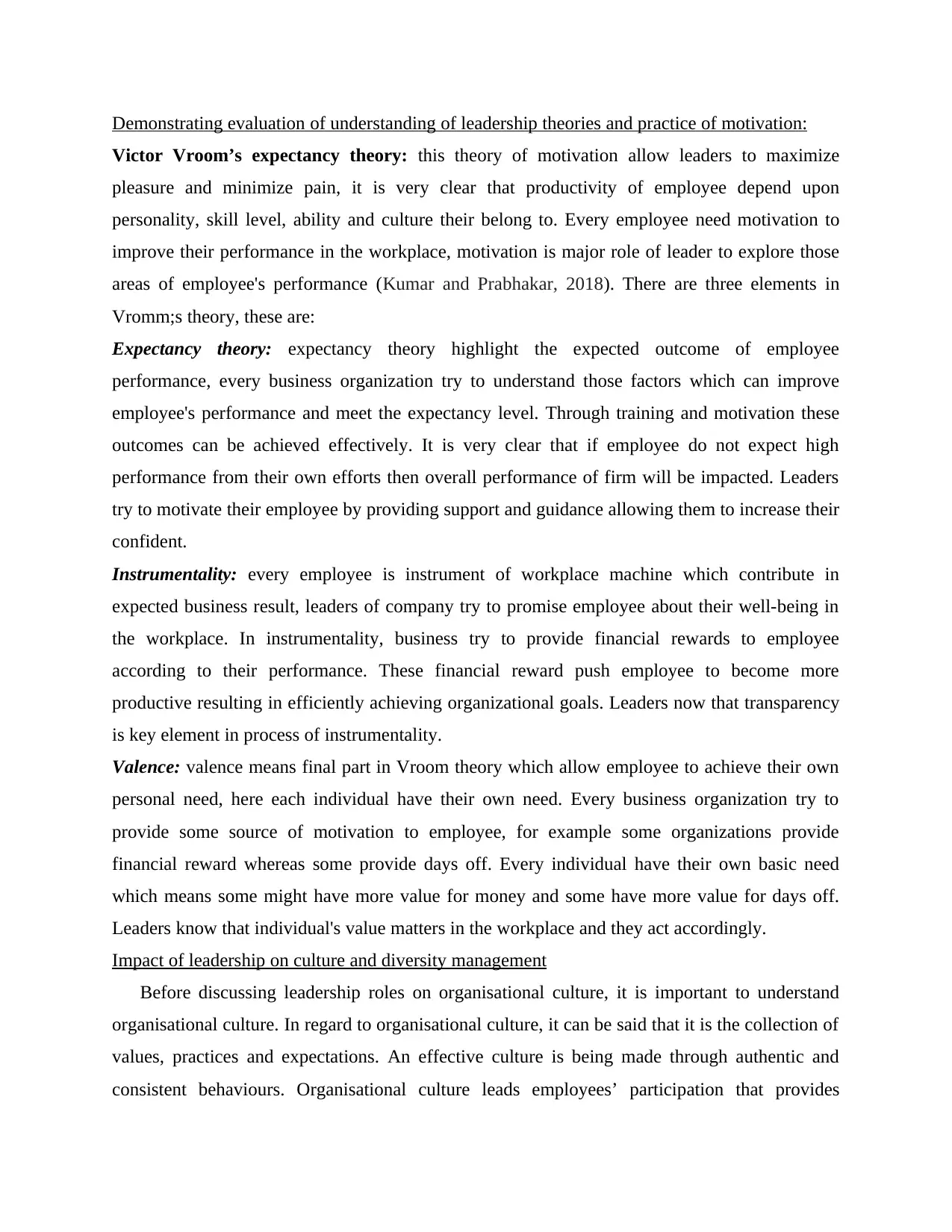
Demonstrating evaluation of understanding of leadership theories and practice of motivation:
Victor Vroom’s expectancy theory: this theory of motivation allow leaders to maximize
pleasure and minimize pain, it is very clear that productivity of employee depend upon
personality, skill level, ability and culture their belong to. Every employee need motivation to
improve their performance in the workplace, motivation is major role of leader to explore those
areas of employee's performance (Kumar and Prabhakar, 2018). There are three elements in
Vromm;s theory, these are:
Expectancy theory: expectancy theory highlight the expected outcome of employee
performance, every business organization try to understand those factors which can improve
employee's performance and meet the expectancy level. Through training and motivation these
outcomes can be achieved effectively. It is very clear that if employee do not expect high
performance from their own efforts then overall performance of firm will be impacted. Leaders
try to motivate their employee by providing support and guidance allowing them to increase their
confident.
Instrumentality: every employee is instrument of workplace machine which contribute in
expected business result, leaders of company try to promise employee about their well-being in
the workplace. In instrumentality, business try to provide financial rewards to employee
according to their performance. These financial reward push employee to become more
productive resulting in efficiently achieving organizational goals. Leaders now that transparency
is key element in process of instrumentality.
Valence: valence means final part in Vroom theory which allow employee to achieve their own
personal need, here each individual have their own need. Every business organization try to
provide some source of motivation to employee, for example some organizations provide
financial reward whereas some provide days off. Every individual have their own basic need
which means some might have more value for money and some have more value for days off.
Leaders know that individual's value matters in the workplace and they act accordingly.
Impact of leadership on culture and diversity management
Before discussing leadership roles on organisational culture, it is important to understand
organisational culture. In regard to organisational culture, it can be said that it is the collection of
values, practices and expectations. An effective culture is being made through authentic and
consistent behaviours. Organisational culture leads employees’ participation that provides
Victor Vroom’s expectancy theory: this theory of motivation allow leaders to maximize
pleasure and minimize pain, it is very clear that productivity of employee depend upon
personality, skill level, ability and culture their belong to. Every employee need motivation to
improve their performance in the workplace, motivation is major role of leader to explore those
areas of employee's performance (Kumar and Prabhakar, 2018). There are three elements in
Vromm;s theory, these are:
Expectancy theory: expectancy theory highlight the expected outcome of employee
performance, every business organization try to understand those factors which can improve
employee's performance and meet the expectancy level. Through training and motivation these
outcomes can be achieved effectively. It is very clear that if employee do not expect high
performance from their own efforts then overall performance of firm will be impacted. Leaders
try to motivate their employee by providing support and guidance allowing them to increase their
confident.
Instrumentality: every employee is instrument of workplace machine which contribute in
expected business result, leaders of company try to promise employee about their well-being in
the workplace. In instrumentality, business try to provide financial rewards to employee
according to their performance. These financial reward push employee to become more
productive resulting in efficiently achieving organizational goals. Leaders now that transparency
is key element in process of instrumentality.
Valence: valence means final part in Vroom theory which allow employee to achieve their own
personal need, here each individual have their own need. Every business organization try to
provide some source of motivation to employee, for example some organizations provide
financial reward whereas some provide days off. Every individual have their own basic need
which means some might have more value for money and some have more value for days off.
Leaders know that individual's value matters in the workplace and they act accordingly.
Impact of leadership on culture and diversity management
Before discussing leadership roles on organisational culture, it is important to understand
organisational culture. In regard to organisational culture, it can be said that it is the collection of
values, practices and expectations. An effective culture is being made through authentic and
consistent behaviours. Organisational culture leads employees’ participation that provides

aligned perspectives between individual and organisational objectives. Overall, it can be said that
organisational culture is being created through employees’ attitude (Mannion and Davies, 2018).
In regard to leadership, it can be said that leaders play a vital role in improving employees’
behaviour within business and it has great impact on organisational culture. There are three main
pillars and factors on which leaders focus for improving organisational culture such as:
Purpose
Accomplishment
One another
Leaders connect their employees with the main purpose and aim of organisation that they
need to accomplish. When leaders connect their people to these all pillars then employees are
more likely to have a strong sense of purpose and they become more engaged with business that
leads an improved organisational culture. Leaders have number of skills and traits such as:
communication, integrity, decision making, problem-solving and ability to improve relations.
With all of these skills, leaders help their people feel connected through frequent one to one
conversations. One to one conversation allows leaders to check in with employees and providing
coaching to employees (Coe, Wiley and Bekker, 2019). For motivating and engaging
employees, leaders appreciate employees on the basis of their performance and it makes
employees feel valued. There are number of software and tools such as: O.C tanner’s culture
cloud that can help employees out this type of conversation and make leaders able to connect
with their employees that reinforce organisational culture.
Along with these, there are number of ways by which leaders focus on culture and lead a
better organisational culture such as:
Observing for insight: Sometimes it is better to sit back for a bit and soak in what is
happening around the office can be good. An effective leader is the one who take in subtle details
about the work environment as it helps leaders out in knowing everything about employees and
lead them accordingly.
Providing an open communication: In question and answer session with senior leaders,
leader provide on spot answers as it helps employees out in solving their doubts and decreasing
miscommunication. It is good to reinforce company’s values and goals as well. An open
communication improves relation of employees with leaders and they are more likely to support
their leaders in accomplishing organisational goals.
organisational culture is being created through employees’ attitude (Mannion and Davies, 2018).
In regard to leadership, it can be said that leaders play a vital role in improving employees’
behaviour within business and it has great impact on organisational culture. There are three main
pillars and factors on which leaders focus for improving organisational culture such as:
Purpose
Accomplishment
One another
Leaders connect their employees with the main purpose and aim of organisation that they
need to accomplish. When leaders connect their people to these all pillars then employees are
more likely to have a strong sense of purpose and they become more engaged with business that
leads an improved organisational culture. Leaders have number of skills and traits such as:
communication, integrity, decision making, problem-solving and ability to improve relations.
With all of these skills, leaders help their people feel connected through frequent one to one
conversations. One to one conversation allows leaders to check in with employees and providing
coaching to employees (Coe, Wiley and Bekker, 2019). For motivating and engaging
employees, leaders appreciate employees on the basis of their performance and it makes
employees feel valued. There are number of software and tools such as: O.C tanner’s culture
cloud that can help employees out this type of conversation and make leaders able to connect
with their employees that reinforce organisational culture.
Along with these, there are number of ways by which leaders focus on culture and lead a
better organisational culture such as:
Observing for insight: Sometimes it is better to sit back for a bit and soak in what is
happening around the office can be good. An effective leader is the one who take in subtle details
about the work environment as it helps leaders out in knowing everything about employees and
lead them accordingly.
Providing an open communication: In question and answer session with senior leaders,
leader provide on spot answers as it helps employees out in solving their doubts and decreasing
miscommunication. It is good to reinforce company’s values and goals as well. An open
communication improves relation of employees with leaders and they are more likely to support
their leaders in accomplishing organisational goals.
⊘ This is a preview!⊘
Do you want full access?
Subscribe today to unlock all pages.

Trusted by 1+ million students worldwide
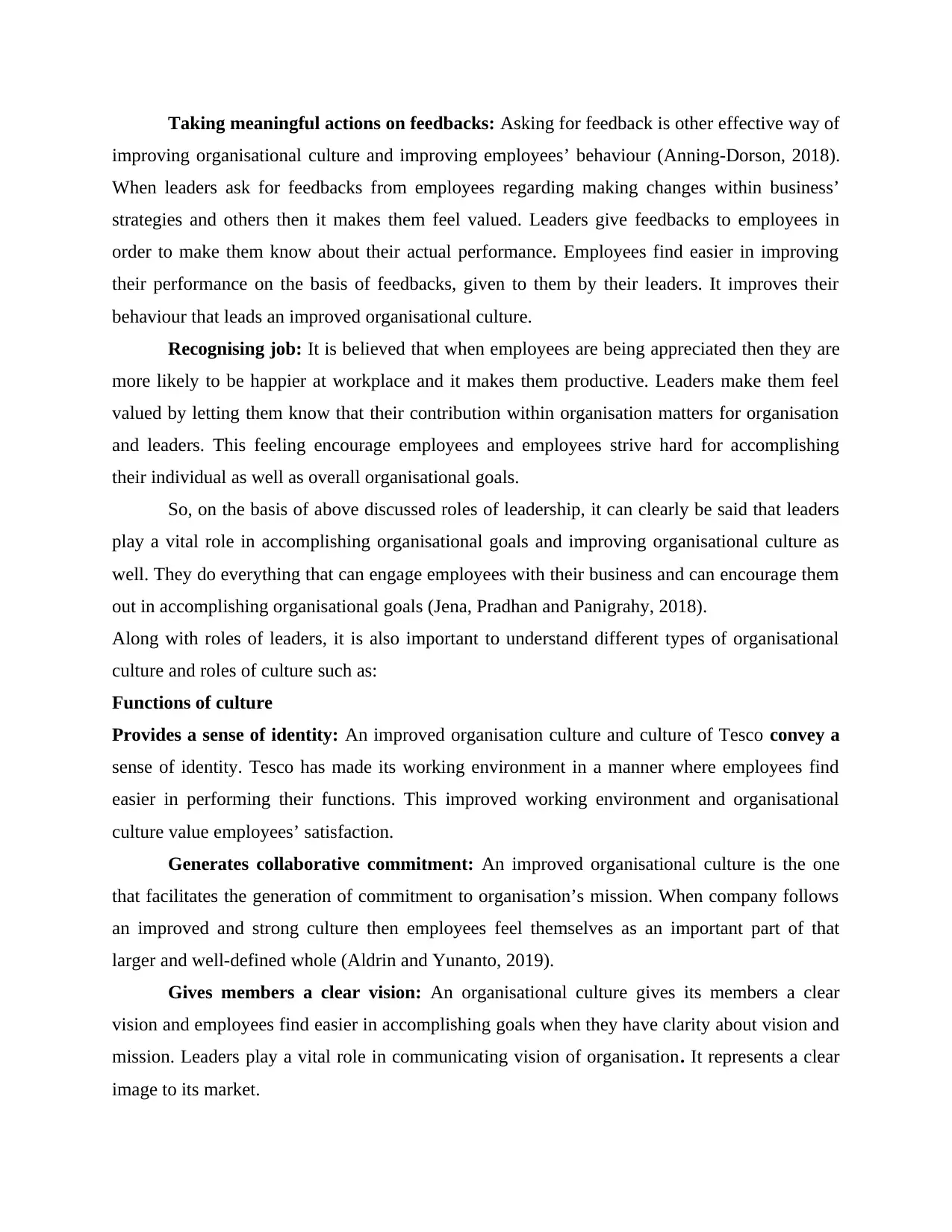
Taking meaningful actions on feedbacks: Asking for feedback is other effective way of
improving organisational culture and improving employees’ behaviour (Anning-Dorson, 2018).
When leaders ask for feedbacks from employees regarding making changes within business’
strategies and others then it makes them feel valued. Leaders give feedbacks to employees in
order to make them know about their actual performance. Employees find easier in improving
their performance on the basis of feedbacks, given to them by their leaders. It improves their
behaviour that leads an improved organisational culture.
Recognising job: It is believed that when employees are being appreciated then they are
more likely to be happier at workplace and it makes them productive. Leaders make them feel
valued by letting them know that their contribution within organisation matters for organisation
and leaders. This feeling encourage employees and employees strive hard for accomplishing
their individual as well as overall organisational goals.
So, on the basis of above discussed roles of leadership, it can clearly be said that leaders
play a vital role in accomplishing organisational goals and improving organisational culture as
well. They do everything that can engage employees with their business and can encourage them
out in accomplishing organisational goals (Jena, Pradhan and Panigrahy, 2018).
Along with roles of leaders, it is also important to understand different types of organisational
culture and roles of culture such as:
Functions of culture
Provides a sense of identity: An improved organisation culture and culture of Tesco convey a
sense of identity. Tesco has made its working environment in a manner where employees find
easier in performing their functions. This improved working environment and organisational
culture value employees’ satisfaction.
Generates collaborative commitment: An improved organisational culture is the one
that facilitates the generation of commitment to organisation’s mission. When company follows
an improved and strong culture then employees feel themselves as an important part of that
larger and well-defined whole (Aldrin and Yunanto, 2019).
Gives members a clear vision: An organisational culture gives its members a clear
vision and employees find easier in accomplishing goals when they have clarity about vision and
mission. Leaders play a vital role in communicating vision of organisation. It represents a clear
image to its market.
improving organisational culture and improving employees’ behaviour (Anning-Dorson, 2018).
When leaders ask for feedbacks from employees regarding making changes within business’
strategies and others then it makes them feel valued. Leaders give feedbacks to employees in
order to make them know about their actual performance. Employees find easier in improving
their performance on the basis of feedbacks, given to them by their leaders. It improves their
behaviour that leads an improved organisational culture.
Recognising job: It is believed that when employees are being appreciated then they are
more likely to be happier at workplace and it makes them productive. Leaders make them feel
valued by letting them know that their contribution within organisation matters for organisation
and leaders. This feeling encourage employees and employees strive hard for accomplishing
their individual as well as overall organisational goals.
So, on the basis of above discussed roles of leadership, it can clearly be said that leaders
play a vital role in accomplishing organisational goals and improving organisational culture as
well. They do everything that can engage employees with their business and can encourage them
out in accomplishing organisational goals (Jena, Pradhan and Panigrahy, 2018).
Along with roles of leaders, it is also important to understand different types of organisational
culture and roles of culture such as:
Functions of culture
Provides a sense of identity: An improved organisation culture and culture of Tesco convey a
sense of identity. Tesco has made its working environment in a manner where employees find
easier in performing their functions. This improved working environment and organisational
culture value employees’ satisfaction.
Generates collaborative commitment: An improved organisational culture is the one
that facilitates the generation of commitment to organisation’s mission. When company follows
an improved and strong culture then employees feel themselves as an important part of that
larger and well-defined whole (Aldrin and Yunanto, 2019).
Gives members a clear vision: An organisational culture gives its members a clear
vision and employees find easier in accomplishing goals when they have clarity about vision and
mission. Leaders play a vital role in communicating vision of organisation. It represents a clear
image to its market.
Paraphrase This Document
Need a fresh take? Get an instant paraphrase of this document with our AI Paraphraser
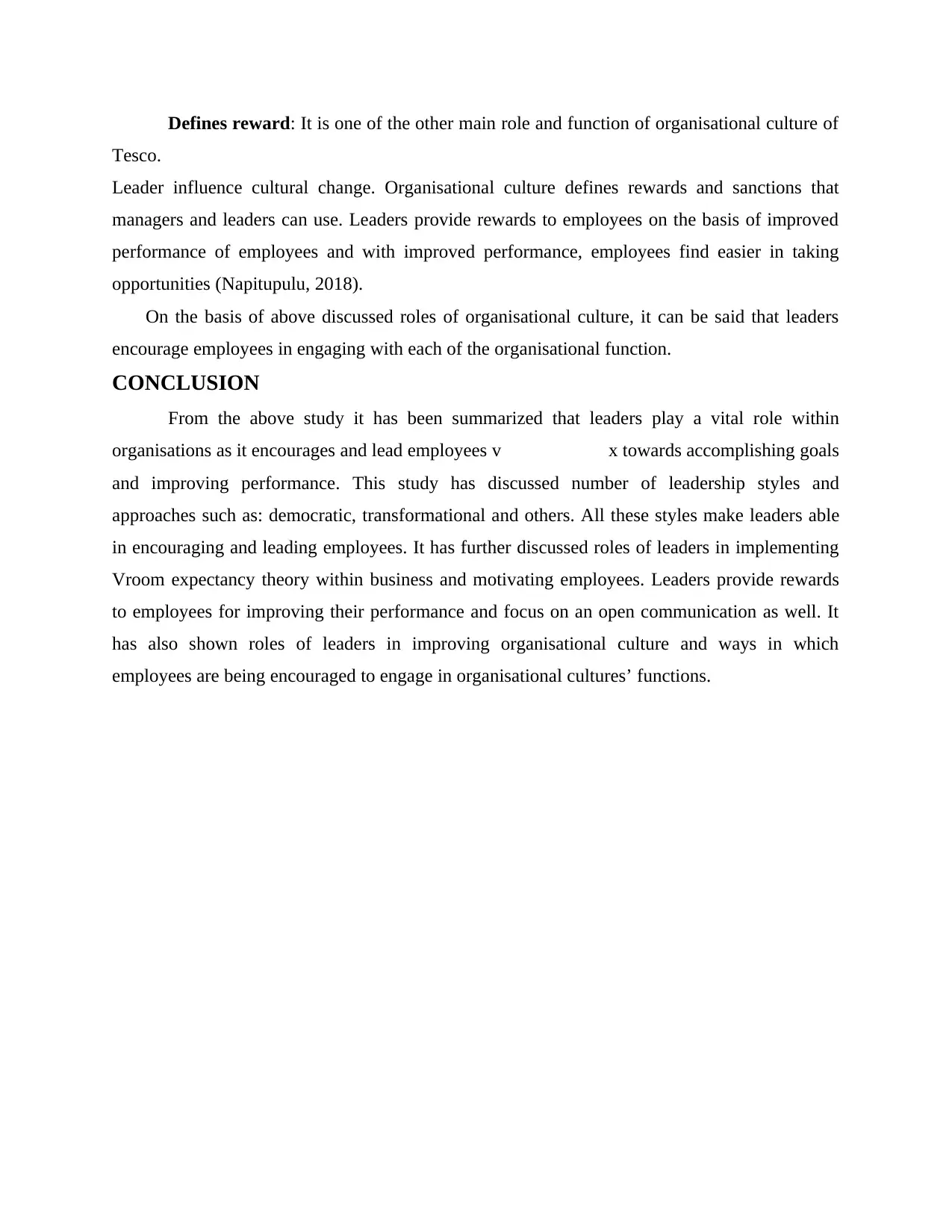
Defines reward: It is one of the other main role and function of organisational culture of
Tesco.
Leader influence cultural change. Organisational culture defines rewards and sanctions that
managers and leaders can use. Leaders provide rewards to employees on the basis of improved
performance of employees and with improved performance, employees find easier in taking
opportunities (Napitupulu, 2018).
On the basis of above discussed roles of organisational culture, it can be said that leaders
encourage employees in engaging with each of the organisational function.
CONCLUSION
From the above study it has been summarized that leaders play a vital role within
organisations as it encourages and lead employees v x towards accomplishing goals
and improving performance. This study has discussed number of leadership styles and
approaches such as: democratic, transformational and others. All these styles make leaders able
in encouraging and leading employees. It has further discussed roles of leaders in implementing
Vroom expectancy theory within business and motivating employees. Leaders provide rewards
to employees for improving their performance and focus on an open communication as well. It
has also shown roles of leaders in improving organisational culture and ways in which
employees are being encouraged to engage in organisational cultures’ functions.
Tesco.
Leader influence cultural change. Organisational culture defines rewards and sanctions that
managers and leaders can use. Leaders provide rewards to employees on the basis of improved
performance of employees and with improved performance, employees find easier in taking
opportunities (Napitupulu, 2018).
On the basis of above discussed roles of organisational culture, it can be said that leaders
encourage employees in engaging with each of the organisational function.
CONCLUSION
From the above study it has been summarized that leaders play a vital role within
organisations as it encourages and lead employees v x towards accomplishing goals
and improving performance. This study has discussed number of leadership styles and
approaches such as: democratic, transformational and others. All these styles make leaders able
in encouraging and leading employees. It has further discussed roles of leaders in implementing
Vroom expectancy theory within business and motivating employees. Leaders provide rewards
to employees for improving their performance and focus on an open communication as well. It
has also shown roles of leaders in improving organisational culture and ways in which
employees are being encouraged to engage in organisational cultures’ functions.
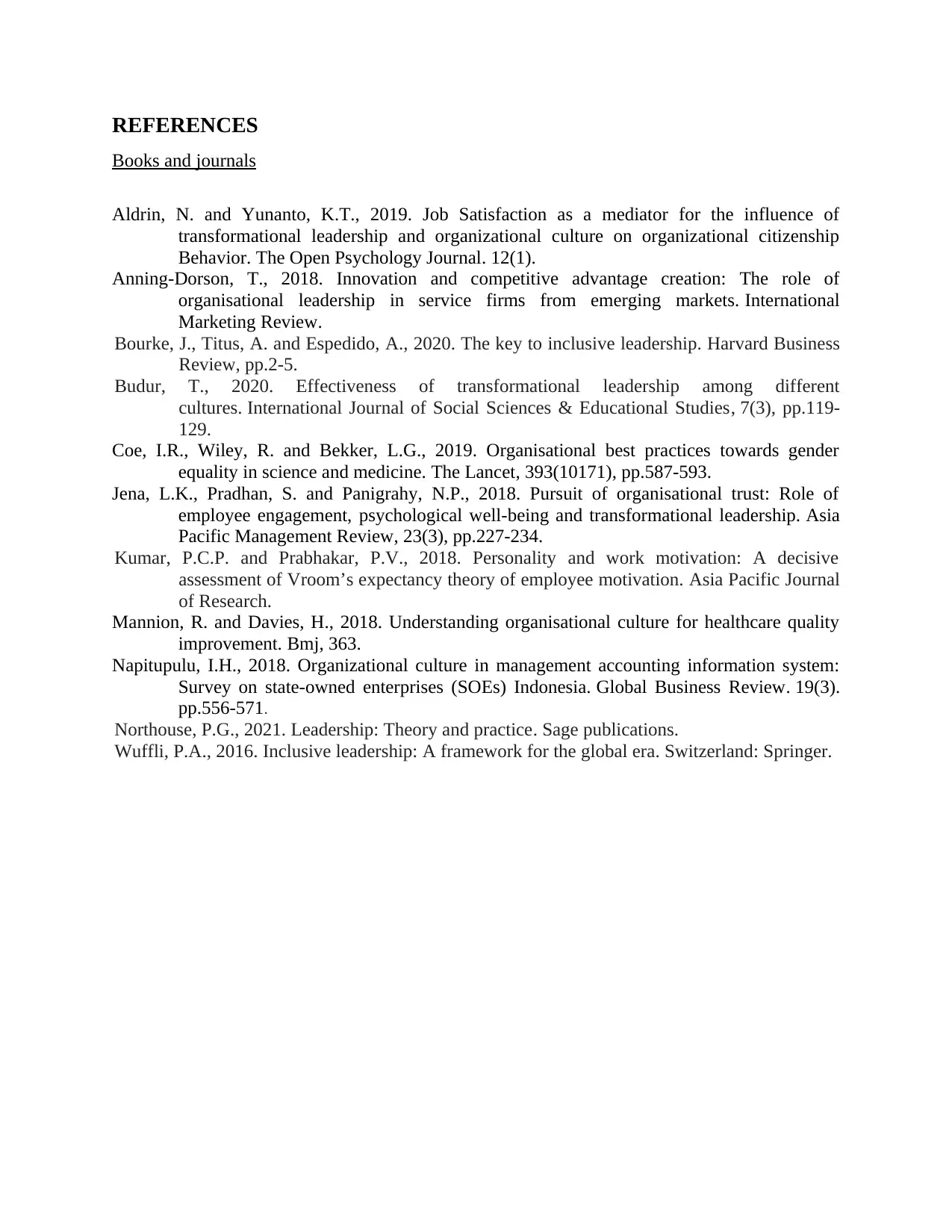
REFERENCES
Books and journals
Aldrin, N. and Yunanto, K.T., 2019. Job Satisfaction as a mediator for the influence of
transformational leadership and organizational culture on organizational citizenship
Behavior. The Open Psychology Journal. 12(1).
Anning-Dorson, T., 2018. Innovation and competitive advantage creation: The role of
organisational leadership in service firms from emerging markets. International
Marketing Review.
Bourke, J., Titus, A. and Espedido, A., 2020. The key to inclusive leadership. Harvard Business
Review, pp.2-5.
Budur, T., 2020. Effectiveness of transformational leadership among different
cultures. International Journal of Social Sciences & Educational Studies, 7(3), pp.119-
129.
Coe, I.R., Wiley, R. and Bekker, L.G., 2019. Organisational best practices towards gender
equality in science and medicine. The Lancet, 393(10171), pp.587-593.
Jena, L.K., Pradhan, S. and Panigrahy, N.P., 2018. Pursuit of organisational trust: Role of
employee engagement, psychological well-being and transformational leadership. Asia
Pacific Management Review, 23(3), pp.227-234.
Kumar, P.C.P. and Prabhakar, P.V., 2018. Personality and work motivation: A decisive
assessment of Vroom’s expectancy theory of employee motivation. Asia Pacific Journal
of Research.
Mannion, R. and Davies, H., 2018. Understanding organisational culture for healthcare quality
improvement. Bmj, 363.
Napitupulu, I.H., 2018. Organizational culture in management accounting information system:
Survey on state-owned enterprises (SOEs) Indonesia. Global Business Review. 19(3).
pp.556-571.
Northouse, P.G., 2021. Leadership: Theory and practice. Sage publications.
Wuffli, P.A., 2016. Inclusive leadership: A framework for the global era. Switzerland: Springer.
Books and journals
Aldrin, N. and Yunanto, K.T., 2019. Job Satisfaction as a mediator for the influence of
transformational leadership and organizational culture on organizational citizenship
Behavior. The Open Psychology Journal. 12(1).
Anning-Dorson, T., 2018. Innovation and competitive advantage creation: The role of
organisational leadership in service firms from emerging markets. International
Marketing Review.
Bourke, J., Titus, A. and Espedido, A., 2020. The key to inclusive leadership. Harvard Business
Review, pp.2-5.
Budur, T., 2020. Effectiveness of transformational leadership among different
cultures. International Journal of Social Sciences & Educational Studies, 7(3), pp.119-
129.
Coe, I.R., Wiley, R. and Bekker, L.G., 2019. Organisational best practices towards gender
equality in science and medicine. The Lancet, 393(10171), pp.587-593.
Jena, L.K., Pradhan, S. and Panigrahy, N.P., 2018. Pursuit of organisational trust: Role of
employee engagement, psychological well-being and transformational leadership. Asia
Pacific Management Review, 23(3), pp.227-234.
Kumar, P.C.P. and Prabhakar, P.V., 2018. Personality and work motivation: A decisive
assessment of Vroom’s expectancy theory of employee motivation. Asia Pacific Journal
of Research.
Mannion, R. and Davies, H., 2018. Understanding organisational culture for healthcare quality
improvement. Bmj, 363.
Napitupulu, I.H., 2018. Organizational culture in management accounting information system:
Survey on state-owned enterprises (SOEs) Indonesia. Global Business Review. 19(3).
pp.556-571.
Northouse, P.G., 2021. Leadership: Theory and practice. Sage publications.
Wuffli, P.A., 2016. Inclusive leadership: A framework for the global era. Switzerland: Springer.
⊘ This is a preview!⊘
Do you want full access?
Subscribe today to unlock all pages.

Trusted by 1+ million students worldwide
1 out of 9
Related Documents
Your All-in-One AI-Powered Toolkit for Academic Success.
+13062052269
info@desklib.com
Available 24*7 on WhatsApp / Email
![[object Object]](/_next/static/media/star-bottom.7253800d.svg)
Unlock your academic potential
Copyright © 2020–2025 A2Z Services. All Rights Reserved. Developed and managed by ZUCOL.





